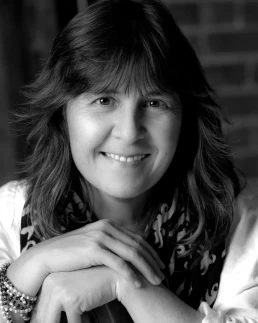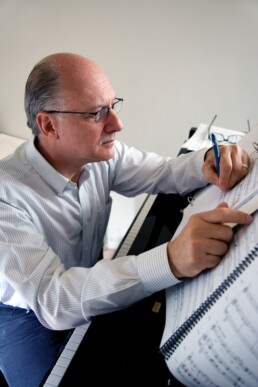ADA Welcomes Chía Patiño
September 05, 2021
ADA
Welcomes Chía Patiño
As of today I’m officially being represented by ADA Artist Management, I am very excited to join their roster! Click the button below to visit my profile at ADA Artis Management website.
La reconocida agencia norteamericana suma a su grupo de artistas a la directora escénica Chía Patiño.
“ADA trabaja para identificar nuevos talentos y fomentar las carreras de los mejores artistas que se destacan en una variedad de géneros y repertorios, desde artistas emergentes hasta artistas de renombre internacional. La agencia trabaja desde 2004 en construir relaciones positivas en toda la industria.”

Upcoming events 2021-22
Upcoming events / Próximos eventos
Orpheus & Eurydice
Music by Christoph Willibald Gluck; Libretto by Ranieri de' Calzabigi
How far would you be willing to go for true love? Travel with Orpheus through an ever-shifting kaleidoscope of darkness and light, as he seeks to rescue his beloved wife Eurydice from the underworld. Set in the intimate Tagney Jones Hall at the Opera Center, with three principal singers and a small orchestra, this captivating production offers a front-row seat to sublime melodies and breathtaking drama. Chía Patiño, former head of Ecuador’s National Theatre, creates an all-new production that puts viewers in the midst of the action, and blurs the line between fantasy and reality.
Jan. 12, 13, 14, 15, 16, 19, 20, 21, 22, 23, 26, 27, 28, 29, & 30, 2022.
Tagney Jones Hall, Opera Center
space
Remembering Daniel Catán
Remembering Daniel Catán
Taken from Wise Music Classical, for complete article please fallow the link below.

Ten years ago this month, the classical music community was shocked by the sudden death of beloved composer Daniel Catán. The loss was most keenly felt in the opera world, where artistic leaders and audiences alike had embraced him and his music with great enthusiasm and respect. Born in Mexico in 1949, Catán went on to earn degrees from prestigious institutions in both the United Kingdom and the United States, including Yale, where he studied with Milton Babbitt. His lush and sumptuous Florencia en el Amazonas was the first Spanish-language opera to be commissioned by a major American company. With his love for opera came a profound understanding of how to write for the human voice, a proficiency that is undoubtedly one of the most important facets of his legacy. His lyrical, romantic operas are not only a pleasure to hear, but a pleasure to sing. Throughout the month of April, we invite you to join Wise Music Classical and artists across Mexico and the United States as we honour his life and his music.
Juan Iñaki: “Hacer un musical fue un cachetazo”
Juan Iñaki: “Hacer un musical fue un cachetazo”
Por Agustin Liotta
HOY DÍA CÓRDOBA

Entrevista Juan Iñaki lanzó “Aquí y ahora” su nuevo disco que presenta este viernes en nuestra ciudad. En una charla con este diario habló de su participación en “Los Miserables”, sus viajes y su carrera
El cordobés Juan Iñaki comenzó desde pequeño a cantar y a lo largo de su carrera compartió escenarios con importantes artistas tanto nacionales como extranjeros, como Lila Downs, Raly Barrionuevo, Dúo Coplanacu, Raúl Carnota, Carmen Paris y Jorge Fandermole, entre otros. De chico decidió perfeccionarse en canto lírico y eso, sin que lo supiera, lo llevó a formar parte del elenco de “Los Miserables”, comedia musical que se montó en Ecuador.
Por estos días se encuentra de gira con la presentación de “Aquí y ahora”, su más reciente disco que se logró en tan solo dos meses de ensayo y grabación, con ideas que le venían dando vuelta en la cabeza desde hace un tiempo. En Córdoba, su ciudad natal, la cita es este viernes a las 21:30, en el Teatro Real.
Hoy Día Córdoba (HDC): De los viajes que realizaste por el mundo, ¿qué te dejaron para tu carrera?
Juan Iñaki (JI): Tengo la suerte de que mi camino me lleva a otros lugares todo el tiempo, a lugares que de otro modo no hubiera conocido. Lo más lindo que me dieron es sacarle el jugo a las situaciones en las que la música me agarro por sorpresa. No es algo pasado sino que sigue sucediendo. Lo que sí puedo decir es que poder retratar Córdoba con otra mirada, me dio la posibilidad de ver otras cosas.
HDC: ¿Esos viajes te permitieron salir de la vorágine de los escenarios?
JI: No, porque los viajes son vorágines y viajo por trabajo. El placer está presente en todo momento porque tengo la suerte de vivir de lo que amo y en contacto con la música soy feliz, es mi goce constante, y mi trabajo también. Ahora me siento ansioso por la presentación del disco porque presentarlo en el lugar donde uno vive tiene algo muy especial.
HDC: ¿Cuál de tus experiencias en el escenario fue la que más te marcó?
JI: Haber protagonizado “Los Miserables” fue algo maravilloso que nunca lo busqué. Aprendí mucho en ese tiempo. Otros momentos que me quedan en el recuerdo son haber teloneado a Caetano Veloso y haber cantando con Lila Downs. Conversar con ella y sentir su cariño son cosas que valoro mucho. Este amor de mis seres queridos me ordena y me encamina.
HDC: ¿Cómo fue eso de “Los Miserables”?
JI: Yo estaba en un festival de Bilbao (España) y me vio la directora de la obra. Ella fue a buscar un tenor español y le pareció que tenía que ser yo. Al año ya pasé a formar parte de la obra. A mí me gustaba la ópera pero tenía un preconcepto con el musical. Me parecía un género menor y fue un cachetazo de aprendizaje el desafío actoral.
HDC: Perteneces a la generación de Abel Pintos y la Sole, ¿Cómo ves esa camada de artistas?
JI: Hoy los veo con mucho más cariño. En ese momento, a finales de los ’90, hubo un boom de niños cantando folklore y yo quería despegarme de eso. Los padres proyectaban mucho sobre los niños. Una vez, Soledad me preguntó si cantaba porque yo quería o porque mis padres me obligaban. ¡Era mi deseo! Ella fue la gran referencia de ese tiempo y yo no era consciente del aporte que hizo. Era casi impensado que una chica que cantaba con bombos sonara en boliches y haya despertado un gran fanatismo en los jóvenes. Hoy no puedo dejar de valorar eso.
Juan Iñaki presenta “Aquí y ahora” este viernes a las 21:30 en el Teatro Real (San Jerónimo 66). Entradas desde 200 pesos en Autoentrada.com.
Cross-Cultural Hybrids, OPERA America
Cross-Cultural Hybrids
By Charles Shafaieh
OPERA America

While a contemporary staging of a standard-repertory item may impose a radical shift in an opera’s setting — from Rigoletto in Las Vegas to La bohème on the moon — the score itself is usually sacrosanct. Some recent productions, though, have broken this unspoken rule. They incorporate novel, often indigenous, instruments and even the translation of entire scores into new musical idioms, in the process broadening the cultural reach of European classics.
The Teatro Nacional Sucre in Quito, Ecuador, has on its payroll an orchestra of Andean instrumentalists but not a traditional ensemble. This gave the company a logistical rationale to create its new, reorchestrated version of The Magic Flute last year, in Spanish and the indigenous language Kichwa. Chía Patiño, the executive and artistic director of Teatro Sucre, devised a production that emphasized the similarities between Andean and Masonic symbolism. Both belief systems place special emphasis on nature, and the serpent in Mozart’s opera is the symbol of the underworld in Andean mythology. The production drew a significant contingent from Ecuador’s Indian communities, many of whom had never before attended an opera. “The people who would recognize Mozart absolutely did, and for the others, it was storytelling, which is what Mozart was trying to do,” Patiño says.
The Andes Magic Flute follows in the tradition of Vancouver Opera’s 2007 First Nations version. A 2014 South African Magic Flute, from the Cape Town-based Isango Ensemble, grew out of a similar impulse to create cultural connections and expand audiences. “South Africa’s conservative operatic audience has never embraced our work, but the result is fantastic when we play abroad or in the townships or Market Theatre in Johannesburg, where the audience is younger and more mixed,” says Mark Dornford-May, the ensemble’s director and the author of Isango’s Magic Flute libretto. “We try to get The Magic Flute to reflect, as close as possible, Mozart’s dream and desire, but we look at it through a South African prism. Our spirits are more like Motown soul singers rather than choirboys; the flute — not a particularly South African instrument — becomes a trumpet. We can show that cultures have different perspectives on things but that ultimately humanity runs across them all.” Using musical adaptations by Mandisi Dyantyis, Isango has also produced a Bohème, and its Carmen served as the basis for the critically acclaimed 2005 film U-Carmen eKhayelitsha.

Creators of these adaptations have to navigate the precarious line between insightful innovation and kitschy cultural appropriation. Guadalajara-based visual artist Gonzalo Lebrija grappled with this dilemma when creating Mariachi Wagner for the Dallas Symphony Orchestra’s SOLUNA Festival in 2018, in collaboration with composer Jesús Echevarría. The all-female ensemble Mariachi Rosas Divinas performed a 40-minute program of Wagner excerpts that Lebrija considered an ideal experiment in revealing the similarities between cultures through music. During initial rehearsals, though, the “Wagner” element dominated the music. “It felt false,” says Lebrija. The creative team adjusted the arrangements so that the mariachi flavor came through. Only when it approached both traditions with equal respect could the fusion take honest shape.
These operatic hybrids suggest tactics for bringing diversity to the field, both in the productions themselves and in their audiences. “The confrontation with antiquated music, text and dramaturgy requires an extra amount of inventiveness and creativity to make it work here and now,” says Amsterdam- based playwright and dramaturg Willem Bruls. “But dealing with old forms can create a different, better and more daring result.”
Charles Shafaieh is an arts writer based in New York City. His work has appeared in The New Yorker, Opera News and other publications.
This story originally appeared in the spring 2019 issue of Opera America magazine, the quarterly of the national nonprofit service organization for opera. Members of OPERA America receive the print and digital editions of Opera America magazine as a benefit of membership. Join today.




